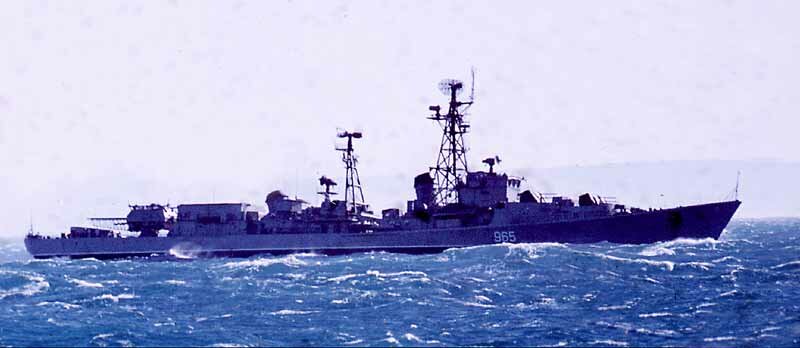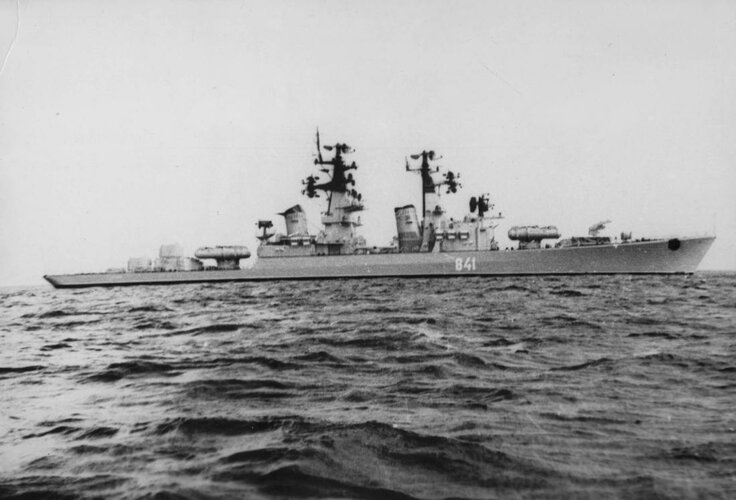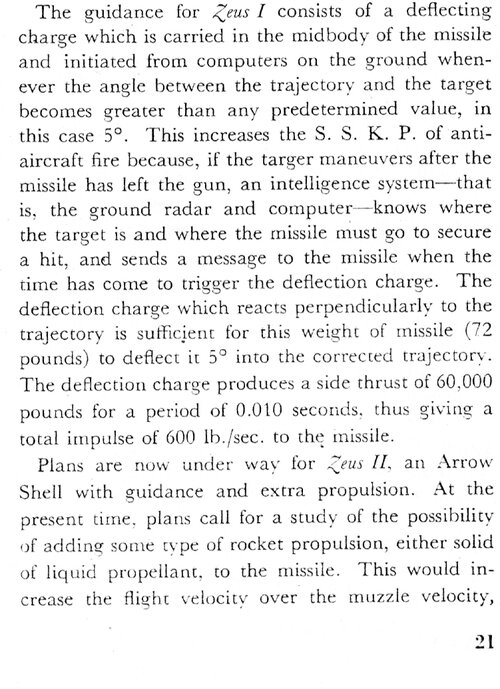Well, Zeus efficient range wasn't significant.
it isn't a long-range system, nothing wrong with that. It's a shorter-range addition to the main SAM system, using functionality of existing multi-purpose gun battery.
What good is a 100-mile SAM, when a bomber(or cruise missile) coming low simply sticks payload into the side, leaving us alone with burning jet fuel. Not the nicest kind of fire to deal with, it's very impolite and requires attention.
I'm not sure. Beam-rider approach seems to be more probable than command guidance one. You see, there is one problem:
* With command guidance, you need to track every shell precisely to feed data to onboard computer that would send commands.
* With beam-riding guidance, you just need to maintain the beam for the shells to orient themselves.
I.e. if Zeus was command-guided, it means that each shell needed to be individually tracked in radar beam. Considering the need for system to reboot itself after each shell, it would drastically affect the rate of fire. The beam-riding approach, in which shells were making decisions for themselves, seems just more practical.
Shells fly ballistic arc, and in the 1940s it was clearly beyond the realm of doable to do active trajectory corrections along the whole trajectory(and we it didn't have enough corrections to adjust to model trajectory anyway).
The simplest explanation is that radar saw them only at the last moment(tracking
target, not shells), giving one general adjustment not long before the interception plane.
The added advantage is that it doesn't limit the volume of fire against a single target - only the number of targets that can be engaged simultaneously.
I.e. it's a basic advantage of all guided AA shells - I don't see why Zeus should've done it differently...unless specifically proven wrong.
But you need not just gun mount, but a specific smoothbore autoloader mount with fast train and elevation. You can't just use existing mounts; you would need to completely replace them with a new ones.
Smoothbore wasn't a specific requirement, as we see from this thread; only Zeus I test articles used that.
Arrows were tested from riffles.
New turrets (automatic 6" and 8" twins) were indeed desirable, however - as they also allowed to significantly offset the loss of volume of fire due to the removal of rear turret(s).
They are not designed to handle high-angle fire.
Up to 45 deg they did, which isn't exactly low, especially for a self-defense system. Whether higher angles would've required it is up to debate - but in any case, degree of changes is below the complete reconstruction path actually taken - so there is still merit here.
The "old strenght" of USN was considered so useless, that FRAM and GUPPY refits were implemented just to maintain more or less modern fleet. Even assuming that those rows of outdated warships would survive the initial nuclear exchange, it would took many months to just make them able to move and fire. And without refits at least in air defense and ECM's - what exactly was the value of those old 8-inch cruisers? To catch the missiles thus protecting more valuable units?
Old strength was considered perfectly useful before ca. 1954-57; they were part of active fleet, and dominated the whole global ocean. They were useless only to the degree that there was literally no worthy opponent at sea - as the only surface fleets worth the name before the late 1950s were the USN and RN.
Units upgraded with missiles were perfectly useful for one more decade - and, as (rather predictable, to be frank) practice has shown, the more heavy guns those ships retained, the more useful they actually were.
The problem is, smaller ships got reasonable upgrade path both for their gun batteries(new FC and evolving 5"/54 mounts) and their new missile part.
Heavier units and heavier guns, which strictly speaking were both more valuable and more perspective - did not, and as a result at some point lost guns at all - only to get their emergency reinstatement in a pretty... pathetic form of single side 5"/38 mounts(open for Albany, back to 1930s) - and ultimately were left with destroyer/light cruiser 5" guns, still without any AA guided ammo even 80 years later.
Without bringing politics in - while it was sorta ironic to watch Russian warships sailing along Ukrainian coast not even able to do anything (4" "bombardment"? SMS Panther is proud), it's clear that something in this path was and still is wrong.
Soviet Navy was perfectly fine with 152-mm guns. Everything larger than that was mainly the attempts to create "supercruiser" from above.
Soviet Navy first requested that 180mm guns could be installed in pr.68 bis, that specifically asked for them and them only for new cruiser designs(project 65, project 84) - until missiles taken over. No way around the fact, that 6" guns, however powerful for this caliber, are just not suitable for longer-range fights, nor can deal with armored targets other than point-blank.
If someone was perfectly fine with 152mm guns - it was the shipbuilding industry: don't mess with the plan, comrade.
[p.s. for Albany quote - let me get home, I'll check where I've taken it from]



